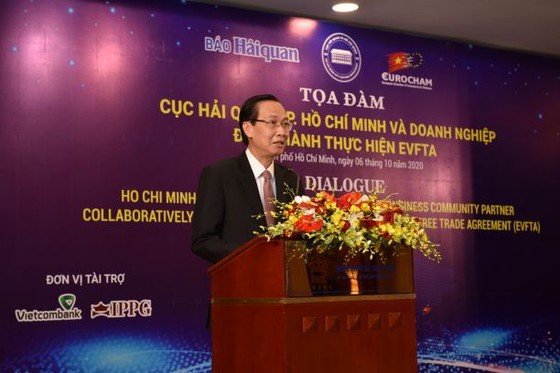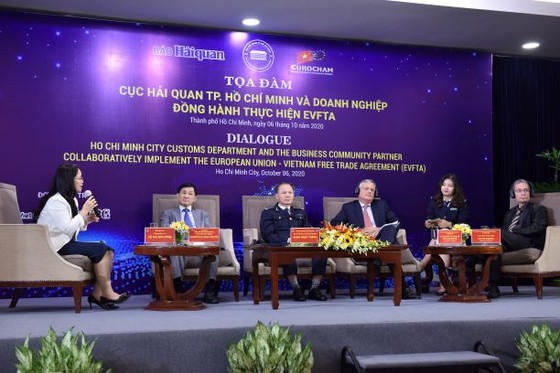
Speaking at the opening of the event, HCMC Standing Vice Chairman Le Thanh Liem said that since Vietnam and the EU officially established diplomatic relations, many opportunities for development cooperation between both sides have opened. Especially, the 30-year cooperation relationship contributes to the driving force for Vietnam and the EU to overcome the difficulties and turbulence of the global economy caused by the Covid-19 pandemic.
 The scene of the dialogue held on October 6. (Photo: SGGP)
The scene of the dialogue held on October 6. (Photo: SGGP)
Ho Chi Minh City is considered as the most dynamic city in the country, ranking third in Southeast Asia according to the assessment by JLL, with strong economic growth over the years. The EU is a traditional market with trade surpluses, the third-largest export partner, and the second-largest importer of the city, with bilateral turnover at US$15.44 billion. Therefore, the EVFTA will widen the door for goods from HCMC to access the market with 500 million people of the EU.
Mr. Johnathan Hanh Nguyen, Chairman of the Inter-Pacific Group (IPP), said that when the EVFTA came into effect, many people said that he would win big as the tariff on goods from Europe into Vietnam will drop sharply. But he thought that all parties would win big in this agreement.
He cited that in the past, for every $100 million worth of luxury fashion goods into Vietnam, if $50 million worth of goods were sold, the company would seek to export the remaining $50 million worth of goods abroad to get the refund of value-added tax (VAT) and import tax due to the high tax rates. European fashion products imported into Vietnam were subject to an import tariff of 30 percent, not including VAT. Meanwhile, the import tariffs of other countries and territories, such as Singapore, Hong Kong (China), and France, were zero percent. Therefore, many tourists, even Vietnamese people, have gone to countries with tax incentives to buy branded goods at low prices. Shortly, Vietnam will have non-tariff shopping malls (Factory outlet) to attract customers, which is expected to welcome about 90 million - 100 million visitors annually.
Mr. Johnathan Hanh Nguyen, Chairman of the Inter-Pacific Group (IPP), said that when the EVFTA came into effect, many people said that he would win big as the tariff on goods from Europe into Vietnam will drop sharply. But he thought that all parties would win big in this agreement.
He cited that in the past, for every $100 million worth of luxury fashion goods into Vietnam, if $50 million worth of goods were sold, the company would seek to export the remaining $50 million worth of goods abroad to get the refund of value-added tax (VAT) and import tax due to the high tax rates. European fashion products imported into Vietnam were subject to an import tariff of 30 percent, not including VAT. Meanwhile, the import tariffs of other countries and territories, such as Singapore, Hong Kong (China), and France, were zero percent. Therefore, many tourists, even Vietnamese people, have gone to countries with tax incentives to buy branded goods at low prices. Shortly, Vietnam will have non-tariff shopping malls (Factory outlet) to attract customers, which is expected to welcome about 90 million - 100 million visitors annually.
 Mr. Dinh Ngoc Thang (L), Director of Ho Chi Minh City Customs Department, gives flowers to the guests participating in the dialogue. (Photo: SGGP)
Mr. Dinh Ngoc Thang (L), Director of Ho Chi Minh City Customs Department, gives flowers to the guests participating in the dialogue. (Photo: SGGP)
Mr. Dinh Ngoc Thang, Director of Ho Chi Minh City Customs Department, emphasized that the dialogue is an opportunity for the customs authority and the business community to exchange and resolve difficulties and problems in the implementation of the EVFTA. To take advantage of tariff incentives effectively, both customs officers and enterprises must understand correctly and implement properly the EVFTA.
























